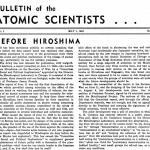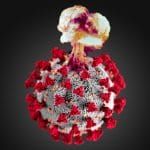Let Hiroshima guide us back to nuclear basics
By Kennette Benedict | May 24, 2016

President Barack Obama’s visit to Hiroshima will demonstrate that the rivalries that lead to war do not last forever. In the years since US warplanes dropped atomic bombs on that city and Nagasaki in August 1945, Japan and the United States have become close allies. But the two nuclear weapons used at the end of World War II also heralded the beginning of a very dangerous era. It continues today, with an existing collective global supply of some 10,000 nuclear weapons, the United States and Russia spending billions of dollars to update their nuclear stockpiles, and India, Pakistan, and North Korea intent on building up their own arsenals.
It’s tempting to say that the problem of nuclear weapons calls for fresh thinking, but in fact, some very useful ideas have been on the table—in some cases, unheeded—since the summer the United States dropped Little Boy and Fat Man, killing tens of thousands of women, men, and children in a flash. Even back then, Manhattan Project scientists at the University of Chicago were beginning to understand the enormous consequences of the new weapons and the challenges of managing their spread. In a report to US President Harry Truman in June 1945—two months before the United States dropped its bombs—scientist James Franck and others conveyed their concerns about how fear and national rivalries would lead to future nuclear arms races.
Early the next year, US Secretary of State James Byrnes directed a committee to study the problem of controlling atomic energy and weapons. In March 1946, it published the Acheson-Lilienthal Report on the International Control of Atomic Energy, named for Undersecretary of State Dean Acheson and David E. Lilienthal, chairman of the five-man board that authored the report and soon-to-be head of the new US Atomic Energy Commission. The new report incorporated ideas from the earlier Franck document and informed US proposals to the newly formed United Nations Atomic Energy Commission.
One of the most remarkable things about the Acheson-Lilienthal report is that, for all the studies and treaties on nuclear weapons that have come since, its observations and proposals are still as sound as anything that has followed. It provides insights even now.
The Acheson-Lilienthal recommendations follow from four basic observations. First, the nuclear bomb is like nothing else ever experienced, a fact that may seem obvious today, but that people were only just starting to grasp in the early aftermath of the bombings. It is a revolutionary weapon that can destroy cities, eradicate populations, and in sufficient numbers and lethality destroy Earth.
Second, the report pointed out that there could be no adequate military defense against nuclear weapons. That’s because the destructive power of just one nuclear bomb is so great, only a shield that prevented every single nuclear-armed missile from hitting its target would suffice, and it’s impossible to build such a shield.
Third, the report noted that no single country would be able to have a monopoly over nuclear weapons. The science upon which the release of atomic energy is based was known throughout the world, so all countries would be able to build these weapons of mass destruction unless methods were devised and incentives created to stop their spread.
Fourth, the report’s most overlooked observation was that fears arising from national rivalries would result in great demand for international enforcement of nuclear arms agreements by police methods. These methods were bound to fail, the authors suggested, because they would generate resentment and the motivation to evade intrusive inspections.
The authors’ solution to this “fatal defect” lay in creating an international organization under the auspices of the newly created United Nations that would provide incentives for cooperating with other countries in research, monitoring, and ownership of nuclear materials. They wrote:
It has become clear to us that if the element of rivalry between nations were removed by assignment of the intrinsically dangerous phases of the development of atomic energy to an international organization responsible to all peoples, a reliable prospect would be afforded for a system of security. For it is the element of rivalry and the impossibility of policing the resulting competition through inspection alone that makes inspection unworkable as a sole means of control. With that factor of international rivalry removed, the problem becomes both hopeful and manageable.
As the Acheson-Lilienthal report makes clear, working together on nuclear science and technology can engender positive relations that support cooperation among nations, and reduce the need for nuclear weapons. Moreover, the authors suggest, a system of cooperative ownership of atomic energy that places nuclear material under international control would render the problem manageable.
Unfortunately, these proposals fell victim to suspicions and rivalry between the United States and the Soviet Union in the early days of the Cold War. But one suggestion did eventually come to fruition: Partly in response to Eisenhower’s Atoms for Peace proposal in 1953, the International Atomic Energy Agency (IAEA) was later established to serve countries interested in developing civilian nuclear energy resources.
As it has evolved since its founding in 1957, the IAEA has made good on two of the Acheson-Lilienthal report’s consequent recommendations: The Agency provides ongoing opportunities for cooperative research on nuclear energy uses in medicine, industry, and agriculture, and it engages in “police-like” inspections. It has not succeeded, however, in one of its other recommendations—that is, in controlling uranium fuel supplies through an international bank jointly controlled by all nations. Such an ownership mechanism would provide enriched fuel for civilian energy and preclude its use in nuclear weapons. (Currently an IAEA fuel bank for low-enriched uranium is under construction in Kazakhstan, but it is unlikely to prevent all nations from enriching their own fuel.)
As many experts suggest, individual countries should take actions to reduce their dependence on nuclear weapons; they provide only an illusion of national security in any event. But we also must find a way to supersede the rivalry and fear that tempts political leaders to acquire nuclear weapons in the first place. The Acheson-Lilienthal report provided a foundation for doing just that, but the full architecture of cooperation that it called for hasn’t been realized. Obama should use his time at Hiroshima to provide blueprints that reinforce and build on the original plans, urgently calling for the international control of all fissile material.
Together, we make the world safer.
The Bulletin elevates expert voices above the noise. But as an independent nonprofit organization, our operations depend on the support of readers like you. Help us continue to deliver quality journalism that holds leaders accountable. Your support of our work at any level is important. In return, we promise our coverage will be understandable, influential, vigilant, solution-oriented, and fair-minded. Together we can make a difference.
Topics: Columnists, Hiroshima & Nagasaki, Nuclear Weapons
Share: [addthis tool="addthis_inline_share_toolbox"]














